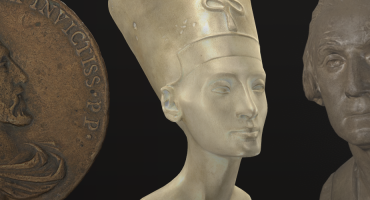Getting Started in 3D
Inca pots, Patagonian dinosaurs, and Rapa Nui cultural artifacts make up just a small sample of the vast natural and cultural heritage that are housed in the National Natural History Museum of Santiago, Chile. Until now, only a small fraction of its collections has ever been exhibited, due to their fragility, and the limited available physical space and resources of the institution. However, in recent years, our museum has embarked on a large-scale process to digitize its collections and scientific production, in order to expand its reach to the global community. First, all publications produced by the museum in the last century have been hosted online for free, and second, we have now begun the 3D digitization of our cultural artifacts and natural specimens. This process is an important step in our goal to democratize access to our national heritage, making it available to everyone in the country and around the world.
Another main advantage of the 3D digitization is the preservation of objects that cannot be manipulated because of their fragility or value. Thus, objects such as the Rapa Nui wooden tablets inscribed with their unique writing system, or the Inca pieces found in the high altitude shrine of El Plomo near Santiago, can be displayed for the first time in decades, without compromising their integrity and heritage value. Observing these pieces will not just be a privilege reserved for specialists, as they are now available to everyone on Sketchfab.
Furthermore, as commissioned by our museum director, Claudio Gomez, all the models posted on Sketchfab’s platform have been publicly released, so they can be downloaded and printed by anyone at home via a 3D printer. We have organized the objects by specific collections on the Sketchfab platform, in order to give meaning and context to the objects on display. The idea is for this virtual exhibition to serve as an educational tool where people can visualize, for example, the diversity and stylistic features of artifacts belonging to the pre-Columbian cultures that inhabited our country, extinct paleontological species, and a glimpse of the biodiversity hosted in our institution. Therefore it is very important for each object to be accompanied by an accurate scientific description to add value and knowledge for viewers, thus going beyond a simple aesthetic experience of observing an attractive 3D digital model.
Tools and Workflow
The process of collection digitization started experimentally in the museum a couple of years ago by using photogrammetry. Motivated by the results, we decided to continue with the next step of doing a large-scale program of 3D digitization for public display. In order to have highly detailed models, including versions that could preserve the colors and textures of the original objects, every artifact was digitized twice by using a 3D laser scan, and photogrammetry.
Thus, we are able to cater not only to the general community, but also to specialists who require sub-millimeter precision for studying specific artifacts’ technical aspects. The team leading this initiative in the museum is comprised of Reynaldo Montenegro and Guillermo Castillo as project managers, Francisco Garrido as curator and manager of the web content, and Jose I. Silva as mass media coordinator. The process of digitization was commissioned to the company Tresdp, specialists in three-dimensional scanning and modelling. During 2018, seventy models will be posted on Sketchfab, with the aim of adding at least a hundred and fifty more models in 2019.
Looking Ahead
We hope to continue along this trajectory by adding more and more models every year. Until now, only anthropological and paleontological objects have been posted on Sketchfab. The challenge remains for digitizing more objects related to the natural sciences, which are not always easy to work with. For example, small insects, fur, transparent objects, feathers, and other small or non-solid objects present high difficulties for scanning with traditional methods. We expect to overcome this challenge in the future to present a broader spectrum of our vast natural collections.
In conclusion, we are proud of being the first museum in South America that is publicly presenting its collections in 3D format, available to everyone in Chile and the world. We expect to promote knowledge and education about our heritage, democratizing access to collections that people would otherwise not be able to interact with because of their uniqueness, fragility, and the lack of space for their physical exhibition. Finally, we invite you to visit our virtual exhibition, and to appreciate the valuable collections that our museum is presenting as part of the 188th anniversary celebration of our institution.









